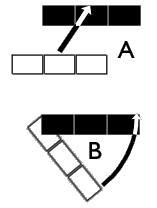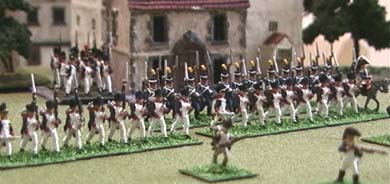|
«
2.1 Movement
Each of the major
troop types used for game play have movement allowances which represent
the total normal distances they are allowed to move during any one player turn.
These allowances are shown in the Movement Box on the Combat Chart. Normal
infantry and cavalry allowances are 20cm and 35cm respectively. Each of these
troop types may also use an assault movement bonus (also called charge
movement), any portion of which may be used during the course of a turn. Normal
infantry and cavalry charge bonuses are 8cm and 13cm respectively. This extra
movement allowance permits a unit to cover a greater distance during its turn,
but use of any of the extra assault movement will also cause the unit to
suffer a morale hit at the end of the turn. Officers and couriers move at the
speed of charging cavalry (48cm).
A unit's movement allowance is based on forward movement as
measured from the front edge of its bases. Units may wheel up to the limit of
their movement, and may move obliquely (diagonally) up to 45 degrees from
perpendicular (See figure at right). Moving backwards counts as rough movement
(double normal cost). Conducting an about-face counts as a formation change.
All movement penalties are cumulative, for example; a unit operating on the
Prussian system of formations change (see below) would move at one-quarter its
normal speed if it were to wheel backwards.
Wheeling and Oblique Movement

Unit A has just completed an oblique movement.
Oblique moves may be conducted up to 45 degrees from perpendicular. Unit B has
just completed a wheel. Wheeling movement is measured along the outermost edge
of the wheel (i.e. - the longest). |
«
2.2 Maneuver
All troops used for
game play are considered to be operating under one of the two basic systems of
maneuver used during this era; the Prussian system and the French system. The
outcome of a battle can be dramatically effected by the selection of maneuver
systems employed. Players will not usually be able to choose which maneuver
system to use. The time period within which a scenario is staged will usually
be the deciding factor for both sides.
Prussian Maneuver System
- The Prussian system of maneuver was used by most nations of Europe for a
great part of the French Revolutionary and Napoleonic Wars. The system was an
extremely complex product of the pre-modern era, and involved a seemingly
endless series of evolutions in order to complete most formation changes.
Because most nations of Europe had closely imitated Prussian maneuver doctrine
since the end of the Seven Years War, all countries fighting against France
during the Revolutionary and Napoleonic Periods should be considered to be on
the Prussian system of maneuver unless otherwise specified. See the troop lists
by nationality (listed on the main Republique page) for more information.
Game Effects: In Republique, units on
the Prussian system suffer the following movement limitations: Wheeling,
oblique movement and passing through other combat units counts as rough (double
normal cost). Moving sideways counts as double rough movement (quadruple normal
cost). Changing formation subtracts 15cm from movement.
French Maneuver System - The French system of
tactical maneuver was pioneered by Comte de Guibert after many years of
research following the Seven Years War. Among many innovations, the new system
allowed units to file off by ranks to their new positions instead of awkwardly
wheeling by sub-units. These improvements greatly reduced the time needed to
change formation and maneuver, giving units who used the system a tactical
advantage against most enemies who still used the Prussian system. The new
system was approved by the French government in 1791, and the benefits were
quickly apparent. Russia, Austria and Prussia probably did not implement their
versions of the system until after 1812. France's German allies were probably
converted to the new system by 1808. Britain appears to have adopted their own
variation of the Prussian system which was efficient enough to be rated in the
same class as the French system.
Game Effects: In Republique, units on
the French system may wheel, pass through other units, move diagonally and move
sideways at normal movement rates. Changing formation subtracts 5cm from
movement.
- «
2.3 Forced Movement
Units required
to move according to a game mandated action or result will do so regardless of
their current turn status or movement allowance. These mandatory or "forced"
moves may occur during the following conditions:
- Movement Phase: Due to skirmish marker
recall and/or evasion due to displacement by advancing enemy combat bases.
- Artillery Phase: Due to morale hits causing
demoralized units to break-up or rout.
- Assault Phase: Rout, Retreat, Withdrawal or
Advance due to assault resolution, emergency rallies or army panic.
- Retrograde forced movements such as rout, retreat and
withdraw are not subject to terrain penalties or formation restrictions (rough
move, about-facing, pass through, etc.), and will always be conducted out to
the maximum distance required for that mandatory order:
- Withdraw = ½ normal move away from
enemy, facing enemy.
- Fall Back = Full normal move away from
enemy, facing enemy.
- Retreat = Full normal move away from enemy,
facing away from enemy.
- Rout = Full charge move away from enemy,
facing away from enemy.
- The forced movement of evading or recalling skirmish
markers may be conducted in any manner which does not violate the skirmish
marker deployment rules. Mandatory advances may be conducted only to the limit
of the moving unit's available movement remaining from the preceding Maneuver
Phase of that Player Turn. Forced advances are in turn subject to cancelation
by subsequent assault rounds which may change the advancing unit's
actions.
- «
2.4 Movement Modifiers
- Road Movement = All infantry and cavalry
units must be in a road column formation in order to benefit from road
movement. Artillery units must be limbered in order to use the road movement
bonus.
- Rough Movement = Any unit with more than
half of any one of its frontage bases within rough terrain will pay
double the normal movement cost. Double normal movement cost means that each
inch of distance moved under rough conditions actually costs two inches of that
unit's available movement allotment for that player turn (see Terrain Effects).
Units also pay double the normal movement cost when conducting difficult
maneuvers (see Maneuver Systems).
 |
| The view above is of
several regiments of French infantry with some of their skirmish markers
deployed (single figures in foreground). Light regiment skirmishers may move up
to 15cm from their parent units. Line regiment skirmishers must remain within
8cm of their parent units. |
« 2.5 Special rules
Skirmishers
- Skirmish capable units may deploy their maximum allowance of skirmish markers
at any time during their movement phase (see troop lists for unit skirmish
allowances). Skirmish markers may be placed anywhere within 8cm from their
parent unit for line infantry based skirmishers, and 15cm from their
parent unit for light infantry based skirmishers. They may not be placed
in a position which puts enemy bases between them and their parent unit, nor
may they be in the primary contact zone between two assaulting combat
formations.
Skirmish markers must always surrender their
positions (i.e. - give ground) to enemy combat bases and, if displaced, have
the following options:
Fighting Withdrawal: If displaced by
enemy units which are not moving to initiate an assault, the skirmish markers
are only required to withdraw until the enemy units have completed their move.
The skirmish markers do not need to return to their parent unit(s).
Break and Run: If displaced by enemy units which are moving to
initiate assault contact, the skirmishers must immediately attempt to return to
their parent unit(s). Markers which are within 5cm of their parent unit may
automatically return. Markers which are greater than 5cm from their parent unit
must remain separated and may be placed alongside or to the rear of their
parent unit. (Also see optional rule:
Dispersing Skirmishers).
Any skirmish markers which fire during the artillery phase may
not rejoin a parent unit at all for the remainder of that player
turn.
Cavalry - Cavalry units may react to enemy units which
advance to within 15cm of their front during an opposing player's
Maneuver Phase. Reacting cavalry may begin moving as soon as enemy units
approach to within line of sight or 15cm, whichever is less. Both sides then
pro-rate their movement until the reacting cavalry and enemy formations have
either completed their movement, contacted or approached within primary assault
range. Reacting cavalry may not change formation. Reacting cavalry may leave
its divisional command radius and may react while out of command range.
Artillery - There are two types of movement for artillery;
Limbered and Prolong. Limbered artillery is attached to a wheeled
carriage drawn by horses. Prolong is unlimbered cannon being drawn by men or
horses while in a "fire ready" condition.
In order to accomplish both
movement and firing, each artillery battery may execute several specific
"functions" during the course of a turn. The available functions are: Move,
Unlimber, Fire, Prolong and Limber. Foot artillery may conduct two functions
each turn, and horse artillery may conduct three functions. For example; a foot
battery may move and unlimber during its movement phase but it may not fire on
its following fire phase. If it were to unlimber in place (without moving), it
could then fire on its upcoming fire phase. Batteries may not use the same
function more than once each turn (i.e. - may not prolong twice during the same
movement phase, etc.). Artillery which prolongs loses simultaneous fire
privilege against enemy artillery and must suffer enemy artillery effects
before they fire.
« 2.6 Terrain
Effects
Battlefield terrain will inevitably affect a units ability
to move freely around the field of battle. The
Battlefield section includes a list
of terrain features and their effects on movement. Units may form their front
line to local terrain such as hillside, woods, blocks of buildings, streams,
etc. Units in the open must maintain their linear deployments within the limits
of the formations section. |

